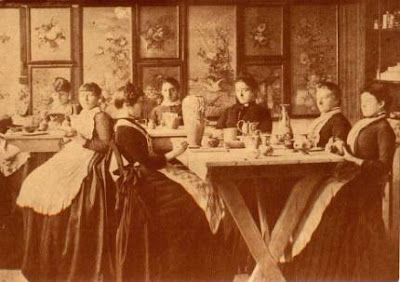Christopher Dresser is one of the foremost designers of the late Victorian period. He was something of a Renaissance man creating designs for every imaginable form of decor: metal wares; ceramics; wallpaper; tile; and furniture. His book, Principles of Victorian Decorative Design was greatly influential in the development of modern design. His earliest designs were Western interpretations of Japanese and Chinese motifs characteristic of the Aesthetic Movement. His incorporation of natural elements in geometric forms became a hallmark of the design motif. In time his work simplified and depended on the streamlining of basic forms, a strong dismissal of the excess of Victorian design and a further synthesis of an incorporation of the Asian aesthetic in Western design. His work with Minton and Wedgwood in particular during the period astonishes today with its cutting edge modernity and beauty of design. It is said that over his lifetime he created over 1,100 designs for pottery.
| Dresser porcelain Fish vase Minton majolica Dresser jardiniere |
Minton majolica Dresser garden seat in the Alhambra style
| Dresser designed Minton Majolica Creamer George Jones majolica Dresser garden seat Minton majolica Dresser jardiniere Minton majolica Dresser sugar bowl Wedgwood majolica Aquaria jardiniere and stand Minton majolica Dresser designed jardiniere |
| Minton majolica Dresser teapot |
| Dresser designed porcelain vases for Mintons Dresser designed vase for Samuel Lear Wedgwood majolica Dresser teapot |
Linthorpe Art Pottery was started by John Harrison in 1879 at the suggestion of Christopher Dresser. Dresser was interested in creating a new type of pottery not found anywhere else. He acted as art superintendent of the pottery until 1881 additionally supplying many of the designs for the new pottery. As was his style the work he created for Linthorpe was forward looking, clean and modern in design. The glazes, based on majolica formulas had a strong metallic component, unique at the time among mass production pottery. Dresser's association with Linthorpe ended around 1882. The pottery continued in production until closing in 1890.
 |
| Decorators at the Linthorpe Pottery |
 |
| Dresser signature for Linthorpe Dresser designed Linthorpe pitcher |
Dresser designed Linthorpe Peruvian Camel pitcher
Dresser designed Peruvian handled Linthorpe vase
Henry Tooth was the in-house artistic manager at Linthorpe from its beginning until 1882. He was responsible for putting into production the designs that Dresser sent in. (Dresser never actually visited the pottery.) Tooth left Linthorpe for a position at the Church Gresley pottery where he met manager William Ault. The two decided to form their own pottery, Bretby Art Pottery. That partnership only lasted for a few years before Ault left Bretby to open Ault Faience in 1887. Bretby operated successfully under several different owners for another 100+ years after Ault left. The work of Bretby most closely resembles the Victorian majolica pioneered by Minton.
 |
| Henry Tooth, co-founder of Bretby Pottery |
Bretbyd majolica Jardiniere
Breathy majolica plant stand Bretby Trompe 'loell leaf plateBretby majolica Parrot wall pocket Bretby majolica wall pocket |
 |
| Bretby impressed signature |
Bretry majolica vases
Bretbys majolica jardiniere |
William Ault was a child of the potteries, born in 1842 at Bagnall in Staffordshire. As a child he worked at Henry Wileman's pottery as a packing boy. Eventually he worked his way up to warehouse manager and then manager at their Church Gresley branch. In 1864, when the factory was purchased by T G Green, Ault stayed on as manager. When Henry Tooth joined the pottery the two of them went into partnership.
The partnership only lasted five years, and in 1887 Ault left to set up Ault Faience which opened in Swadlincote in 1888. Much of the art work at the pottery was done by his daughters Clarissa and Gertrude on molds purchased from the closed Linthorpe Pottery.
 |
| William Ault |
Ault opened showrooms in London and exhibited at the international trade shows. In addition to the Dresser designs Ault potted more conventional forms such as the Toby pitcher shown below. It became a full range art pottery manufacturer. He was also a Wesleyan Methodist preacher, and was active in his community.
| Ault Pitcher based on a Dresser mold |
| Ault pitcher based on Dresser Persian Ewer for Linthorpe |
Many Ault pieces retained a facsimile of the Dresser signature. Others used the Dresser forms as a base for the type of hand painted art pottery that was coming into vogue at the turn of the century. Dresser teamed with Ault in 1892 and contributed designs to Ault until 1896. New Dresser designs continued to be manufactured by Ault until 1909, five years after Dresser's death. In 1922, at the age of 80, Ault decided to retire, and the company merged with the Ashby Potters' Guild.
Dresser developed his style in the 1870s in accordance with Asian design and influenced Art Nouveau, Arts and Crafts and the developing Art Deco designs long after his death. Dresser died at the age of 70 in 1904.


























































No comments:
Post a Comment